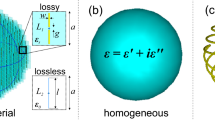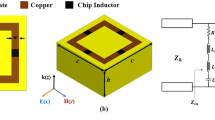Abstract
The scientific research on metamaterials has achieved significant progress in recent years. In contrast, the related practical applications have encountered tough challenges. The insufficient homogeneity makes these artificial media lose its competitiveness to conventional continuous media. In this work, we propose a generalized approach to realize microwave metamaterials with ultra-subwavelength unit cells constructed with rolled-up transmission lines. As an illustration, we design and fabricate a bulk left-handed material sample with standard printed circuit board technique. With the normalized periodicity of the unit cells ranging from 1/61 to 1/48 of wavelength, the negative refractive index can be clearly measured in the frequency range between 1.02 and 1.3 GHz. Simulation shows that by employing the planar process for semiconductor integrated circuits, this homogeneity can be further improved to a level of 1/300 of the wavelength at gigahertz frequencies. Our work also provides a new method for obtaining ultra-small microwave resonators, which can be widely used for all kinds of planar technologies.







Similar content being viewed by others
References
J.B. Pendry, A.J. Holden et al., Extremely low frequency plasmons in metallic mesostructures. Phys. Rev. Lett. 76, 4773–4776 (1996)
J.B. Pendry, A.J. Holden et al., Magnetism from conductors and enhanced nonlinear phenomena. IEEE Trans. Microw. Theory Technol. 47, 2075–2084 (1999)
R. Marqués, F. Mesa et al., comparative analysis of edge and broadside coupled split ring resonators for metamaterial design theory and experiments. IEEE Trans. Antennas Propag. 51, 2572–2581 (2003)
D. Schurig, J.J. Mock et al., Electric-field-coupled resonators for negative permittivity metamaterials. Appl. Phys. Lett. 88, 041109 (2006)
G.V. Eleftheriades, O. Siddiqui et al., Transmission line models for negative refractive index media and associated implementations without excess resonators. IEEE Microw. Wirel. Compon. Lett. 13, 51–53 (2003)
R.A. Shelby, D.R. Smith et al., Experimental verification of a negative index of refraction. Science 282, 77–79 (2001)
S. Xi, H. Chen et al., Experimental verification of reversed Cherenkov radiation in left-handed metamaterial. Phys. Rev. Lett. 103, 194801–194804 (2009)
N. Seddon, T. Bearpark, Observation of the Inverse Doppler effect. Science 302, 1538–1540 (2003)
J. Carbonell, L.J. Roglá et al., Design and experimental verification of backward-wave propagation in periodic waveguide structures. IEEE Trans. Microw. Theory Technol. 54, 1527–1533 (2006)
A. Grbic, G.V. Eleftheriades, Experimental verification of backward-wave radiation from a negative refractive index metamaterial. J. Appl. Phys. 92, 5930–5935 (2002)
D. Schurig, J.J. Mock et al., Metamaterial electromagnetic cloak at microwave frequencies. Science 314, 977–980 (2006)
J.B. Pendry, Negative refraction makes a perfect lens. Phys. Rev. Lett. 85, 3966–3969 (2000)
A. Erentok, R.W. Ziolkowski et al., Lumped element-based, highly sub-wavelength, negative index metamaterials at UHF frequencies. J. Appl. Phys. 104, 034901–034911 (2008)
P.W. Kolb, T.S. Salter et al., Extreme subwavelength electric GHz metamaterials. J. Appl. Phys. 110, 0549061–0549065 (2011)
X. Chen, Y.Q. Li et al., Design and analysis of lumped resistor loaded metamaterial absorber with transmission band. Opt. Express 20, 28347–28352 (2012)
X. Zhang, E. Usi et al., Extremely sub-wavelength negative index metamaterial. Prog. Electromagn. Res. 152, 95–104 (2015)
D.R. Smith, W.J. Padilla et al., Composite medium with simultaneously negative permeability and permittivity. Phys. Rev. Lett. 84, 4184–4187 (2000)
D.R. Smith, J.B. Pendry et al., Metamaterials and negative refractive index. Science 305, 788–792 (2004)
D. Ye, K. Chang et al., Microwave gain medium with negative refractive index. Nat. Commun. 5, 1–7 (2014)
J.D. Baena, R. Marqués et al., Artificial magnetic metamaterial design by using spiral resonators. Phys. Rev. B. 69, 0144021–0144025 (2004)
R. Marqués, F. Medina et al., Role of bianisotropy in negative permeability and left-handed metamaterials. Phys. Rev. B. 65, 1444401–1444406 (2002)
D.R. Smith, S. Schultz et al., Determination of effective permittivity and permeability of metamaterials from reflection and transmission coefficients. Phys. Rev. B. 65, 1951041–1951045 (2002)
X. Chen, T.M. Grzegorczyk et al., Robust method to retrieve the constitutive effective parameters of metamaterials. Phys. Rev. E 70, 0166081–0166087 (2004)
K. Aydin, K. Guven et al., Observation of negative refraction and negative phase velocity in left-handed metamaterials. Appl. Phys. Lett. 86, 1241021–1241023 (2005)
T. Koschny, P. Markoš et al., Impact of inherent periodic structure on effective medium description of left-handed and related metamaterials. Phys. Rev. B. 71, 2451051–24510522 (2005)
T. Koschny, P. Markos et al., Resonant and antiresonant frequency dependence of the effective parameters of metamaterials. Phys. Rev. E 68, 0656021–0656024 (2003)
H. Chen, J. Zhang et al., Experimental retrieval of the effective parameters of metamaterials based on a waveguide method. Opt. Express 14, 12944–12949 (2006)
Acknowledgements
This work was supported by the NSFC under Grants 61771422, 61675013, the ZJNSF under Grants LR18F010001 and LY16F010009, the Program for the Top Young Innovative Talents under Grant Q1313-03.
Author information
Authors and Affiliations
Corresponding author
Additional information
Publisher's Note
Springer Nature remains neutral with regard to jurisdictional claims in published maps and institutional affiliations.
Rights and permissions
About this article
Cite this article
Cao, C., Chen, L., Zhu, Z. et al. Homogenization of artificial media with a transmission line approach. Appl. Phys. A 126, 238 (2020). https://doi.org/10.1007/s00339-020-3420-0
Received:
Accepted:
Published:
DOI: https://doi.org/10.1007/s00339-020-3420-0




